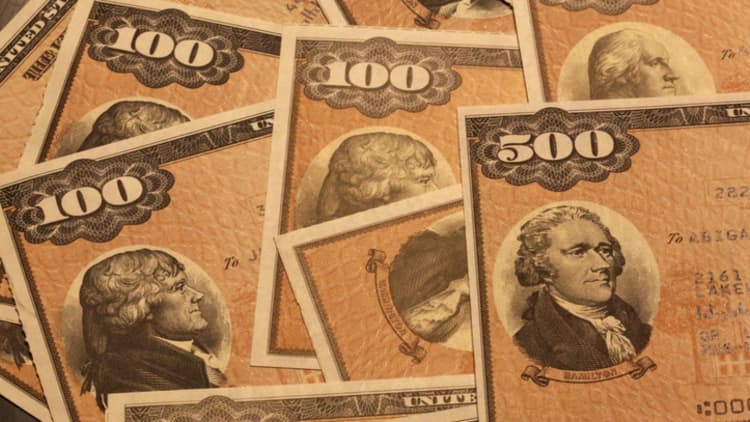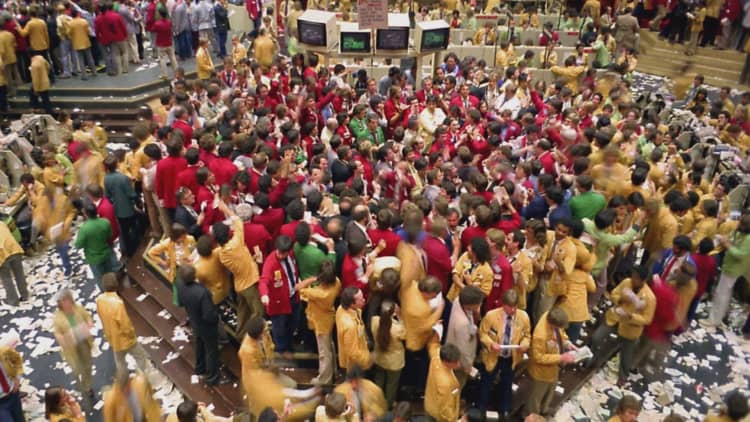
There's a not-so-quiet rebellion going on in the bond market, and it threatens to take 10-year yields above 3 percent much faster than expected just a few weeks ago.
As a result, the bumpy ride for stocks could continue for a while.
There are some powerful forces at work, with global growth strong, central banks moving to tighten policy and the government's deficit spending creating more and more Treasury supply. So, the bond market has entered a zone of no return for now, where Treasurys are expected to price in higher yields in a global sea change for bonds.
Thursday's sharp sell-off in stocks, with the closing down 3.8 percent , reversed a sharp move higher in bond yields, as buyers sought safety. The 10-year yield was at 2.81 percent from a high of 2.88 percent earlier in the day and the rising yields had started the stock market spiral lower.
"There's going to be an interplay, a bit of push and pull between the rates market and equity market," said Mark Cabana, head of U.S. short rate strategy at Bank of America Merrill Lynch.
Cabana said his call for a 2.90 percent 10-year this year is clearly at risk. He said technicians are watching 2.98 percent, and then 3.28 percent on the charts.
Source: CNBC
The bipartisan spending bill, expected to pass Congress, called for a higher-than-expected spending cap of $300 billion. Cabana said it was encouraging in that the deal was bipartisan and that means the debt ceiling won't be an issue. But it also had a negative impact on the bond market and resulted in forecasts of more Treasury supply and higher $1 trillion deficits.
"It signals that fiscal austerity out of D.C. is a thing of the past, and Republicans aren't nearly as concerned with the overall trajectory of the deficit as they have been and the president is worried about it," he said.
The 10-year Treasury is the one to watch, and while many strategists targeted rates under 3 percent for this year, they acknowledge the risk is to the upside with yields potentially climbing to 3.25 percent. The 10-year is the benchmark best known to investors, and its yield influences a whole range of loans, including home mortgages.
Strategists say the level of the yield is not so much the problem. Rather, it's the rapidity of the move that has proven unnerving for global stock markets.
"We're in a vicious cycle here. If the yields go up, you have to sell stocks. If you sell stocks, and they crash, yields come back down," said Art Hogan, chief market strategist at B. Riley FBR.
The bond market's struggle to price in higher interest rates has been kneecapped each time the stock market reacts and sells off. Strategists expect the two markets to ultimately find an equilibrium but not without more sharp swings.
"It's as correlated as it's ever been to anything," said Hogan.
The question for investors is how high do yields go. For Hogan, the 10-year yield's recent break through 2.63 percent, its 2017 high, signaled the inevitable move to 3 percent. The yield started the year at about 2.43 percent.
Rising yields challenge equity prices and make investors reassess valuations.
"What's the right multiple you're willing to pay?... A low 3 percent is a target that just seems to be a magnet now. It seems the new [10-year yield] range will be 2.75 to 3.25. ... That's not a problem, it's just that it's February and we're already at 2.88. It's the pace," Hogan said. He said recently when Treasury yields were in the low 2 percent range, price-to-earnings multiples were able to get to about 18 percent.
"In the day of the 5 percent 10-year, the average P/E was 15.5," he said.
Jim Caron, portfolio manager at Morgan Stanley Investment Management, said he expects the range for the 10-year now to be 2.50 to 3.25 percent.
"The answer to this will reset the level of risk premia, or risk tolerance for other asset prices," Caron said in a note. "It seems the risk premia is being reset to a new, higher level. This is not a bad thing, it's a normal and common readjustment in the market. Once we find that new range and understand the tolerances, then it's back to business as usual."
The 3 percent level is important because it's a big round number that stock strategists have pointed to as a zone that would make stocks uncomfortable. But with the yield topping 2.88 percent Thursday and the S&P down 7 percent in the past week, stocks are already uncomfortable.
"I think 2.90 could be broken at any point in the next 36 hours," said Andrew Brenner of National Alliance. That would make 3 percent the next stop. Brenner said the U.S. yield was tethered to the German bund yield early Thursday, and both moved up together. That could be another influence overnight.
"We're going to have another race to the bottom" if stocks stabilize, Brenner said.
WATCH: Five strategies you should use to protect your portfolio



